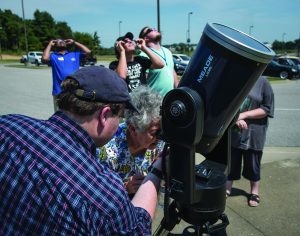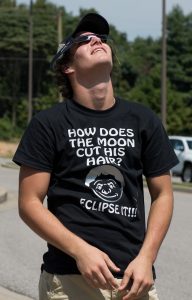
Photo by Darrin Phegley

The majority of Henderson looked to the skies in both awe and wonder on August 21 at 1:24 p.m. During the early afternoon, the sunlight dimmed, cicadas could be heard, and residents may have felt a drop in temperature.
On that day a solar eclipse could be seen from coast to coast across the continental United States — an event that hadn’t occurred since 1979. Even though Henderson was only within the 99.56% zone, unlike their Hopkinsville neighbors who experienced 100% totality, residents felt the swelling anticipation both on the day and the week leading up to the eclipse.
According to Scott Taylor, an associate professor of mathematics at Henderson Community College who presented on the eclipse that Monday, the 99.56% zone was 1,000 times brighter than it would have been had Henderson been in the 100% zone.
Students across the Henderson County School District and residents from around the area gathered at HCC to hear Taylor speak about the eclipse. He covered the basics of astronomy, sizes and types of stars, origins and properties of the Moon, and the Moon’s influences on Earth.

“I pointed out how bright and, frankly, unnoticeable anything was when the moon had covered half of the sun,” said Taylor, who has hosted numerous night-time observation and astronomy community education events. “Until the sun was almost entirely covered, there was almost no change in general temperature or brightness. However, at the time of maximum obscuration, I addressed not only the obvious difference in luminosity, but also that insects were chirping as if it were dusk and that it was substantially cooler.”
According to a press release from HCC chief advancement officer Jennifer Preston, nearly 800 Henderson County School students attended the lecture and viewed the eclipse from the parking lot through a telescope that included a solar filter.
“During the time of maximum obscuration, I noticed the increase in nocturnal animal activity, how significantly cooler campus had gotten, and the uniqueness of the light,” said Taylor. “It was not at all akin to dusk where the light was refracted and a different color. It was a different and unexpected form of darkness.”
HCC wasn’t the only location for interested eclipse viewers either. Bend Gate Elementary School scheduled a whole week of solar eclipse related activities leading up to the big event for their students. With science-centered activities and lessons focused on impacts eclipses had on ancient cultures, Bend Gate students were primed for the day.
On the day of the eclipse, students were allowed to watch the event on the lawns of Bend Gate. With the peak of the eclipse being at 1:24 p.m., teachers were given the flexibility to take their classes in and out between the hour of 1 p.m. and the peak of total obscurity.

“Safety was the school’s primary concern,” said Bend Gate Principal, Deborah Harmon. “Our teachers practiced with their students on how to put the glasses on and how they needed to keep their glasses on. With the smaller students, we had them create screens for their glasses and they decorated them throughout the week.”
Donned in glow-in-the-dark t-shirts that read, “The day Bend Gate went dark,” students, teachers, and some parents chowed down on solar eclipse-themed snacks like Moon Pies and Starbursts while lying on blankets to watch the astronomical event.
According to first-grade teacher Alicia Garrett, her class went outside three separate times during the day to see the sun during separate stages of the eclipse. Students who didn’t have permission from their parents to watch the eclipse watched the movie Space Buddies in the school gym.

“Some parents didn’t want their children watching the eclipse because they were concerned about their children’s eyesight,” said Harmon. “We also had a live feed of the eclipse broadcasted on a corner of the screen. I didn’t want those students to feel punished because their parents were concerned, so we made it a fun day for those students too.”
For those who had wished to see the solar eclipse at 100% totality, they will have another opportunity in seven years. During 2024, the United States will be able to see the next solar eclipse, and Henderson will be in the 100% zone of totality.
“Regardless of one’s personal political views, religion, or other ideology, science transcends and influences us all, and human understanding of science is paramount to our growth as a society for myriad reasons, the most obvious of which being technological advancement,” said Taylor. “We’re a scientifically-rooted nation, and I think it’s important to try to cultivate a sense of passion and wonder in the community about such phenomenon.”
Share Your Comments & Feedback